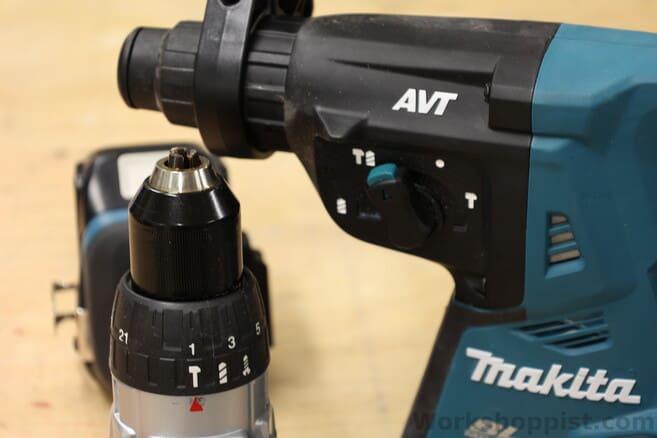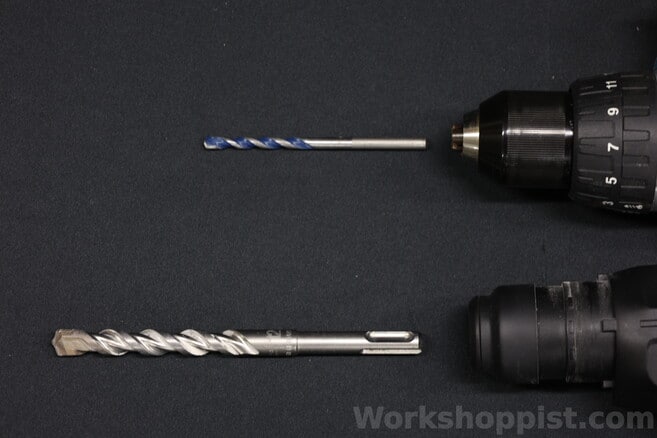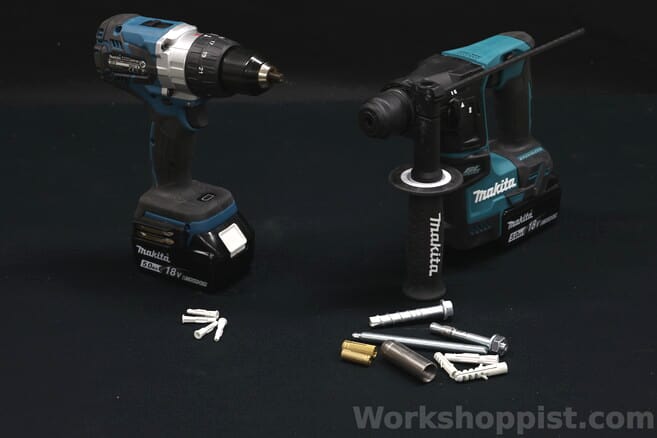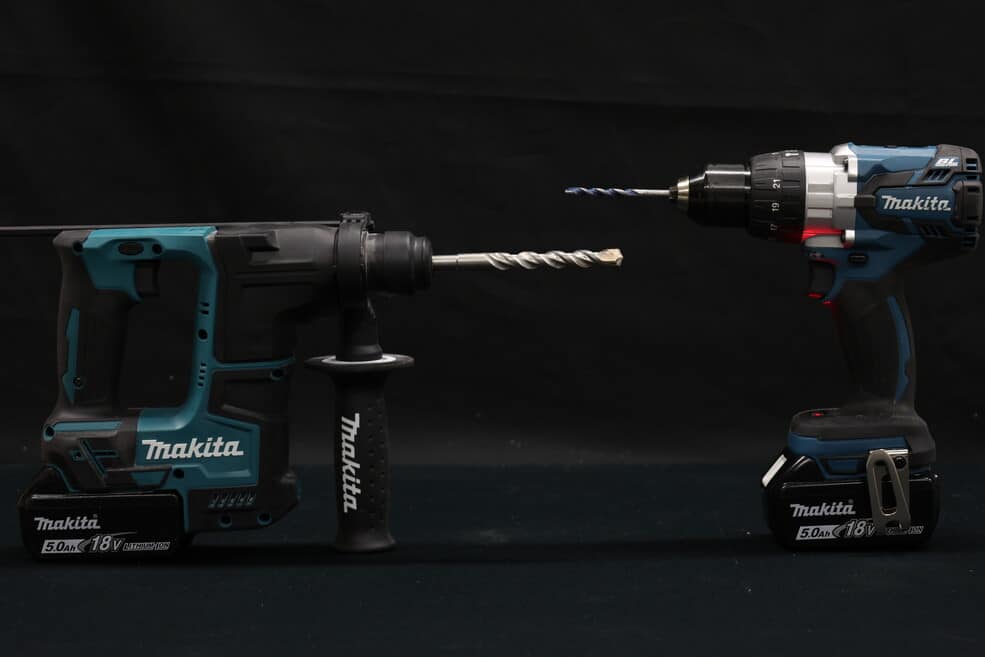When drilling small holes to concrete, you have two tools to choose from: a hammer drill (impact drill) or a rotary hammer. The tools work just the same: knock and rotate the bit. But they are called different because they generate the impact in different ways, and rotary hammer is the one with more impact power – most web sources will tell you this much.
But how much more powerful rotary really hammers are? And what are all the other differences besides the hammer mechanism? If you are considering which tool to get, you are probably interested in the bottom line: how well each drills into concrete, and what else can they do.
In this article, I am going to tell you the bottom line difference between impact drills and rotary hammers. In short, hammer drills have a weaker impact, drilling rate below 5 in/min (2 mm/s), and are practical only for drilling a few holes 1/4” (6 mm) or smaller into strong concrete. Rotary hammers have a more powerful impact, offer faster drilling rates of 12…17 in/min (5…7 mm/s) and drill up to 1-3/16” holes into hard concrete. In practice, a hammer drill is sufficient for occasionally drilling a few small holes, and a rotary hammer is always recommended for holes larger than 1/4” (6 mm) or when productivity is important.
We will next examine the typical specifications, drilling capacity and construction of hammer drills and rotary hammers more closely. If you just want to find out which one you need, you can skip to the end where I list the user profiles for the two tools.
Hammer drill vs. Rotary hammer: Typical Specs
The table below compares the main specifications of typical cordless hammer drills and rotary hammers, and gives you a good overview of the two tools in numbers.
| Hammer drill* (Impact drill) | Rotary hammer* | Notes | |
|---|---|---|---|
| Functions | drilling driving impact drilling | impact drilling (drilling) (driving) (chiseling) | main (optional) |
| Impact energy | < 1 ft.lb < 1 J | 1…8 ft.lb 1…10 J | |
| Max D concrete | 1/4” (6 mm) | 1” (typ.) (25 mm) | |
| Drilling rate | 0…5 in/min (0…2 mm/s) | 12…17 in/min (5…7 mm/s) | faster into soft concrete |
| RPM | 2000 | 800…1200 | |
| BPM | 30k…50k | 4500…5500 | (Beats Per Minute) |
| Chuck | 3-jaw | SDS+ | bits incompatible |
| Weight | 3…6 lb. | 5…10 lb. | w. battery |
| Cost | < $150 | $150…$1000 | tool body |
| *typical cordless, 2021 |
Hammer drills are mainly for regular drilling and driving screws, but can also slowly impact drill holes up to 1/4” into concrete. They have low impact energies below 1 ft.lb or 1 J, high RPM and BPM and a 3-jaw chuck; they’re light and affordable.
Rotary hammers are mainly for impact drilling, have high impact energies above 1 ft.lb or 1 J and can drill holes up to around 1” diameter into concrete at rates of more than 10 inches per minute. They have relatively low RPM and BPM and an SDS chuck. At more than $150 (cordless, tool body) and 5 lb., rotary hammers are heavier and more expensive than hammer drills.

How fast are they?
The key performance parameter for hammer drills and rotary hammers is drilling capacity: how large holes, and how fast.
There is no maximum hole size you can drill with either hammer drills or rotary hammers. Holes that are too large holes will just take impractically long to finish. Drilling capacities are therefore best compared through drilling rate, meaning how fast the hole progresses.
The tables below list drilling rates for hammer drills and rotary hammers at different hole diameters. The numbers are given in inches per minute (in/min) or millimeters per second (mm/s) and come from my own measurements (see comments below).
The rates may be easier to understand as drilling times for standard-depth holes. A third table below lists drilling times for 2” deep holes, and I provide more commentary there.
| Imperial Hole diameter [in] | DRILLING RATE Hammer drill* [inches per min] | into hard concrete Rotary hammer** [inches per min] |
|---|---|---|
| 3/16” | 4 in/min | 12 in/min |
| 1/4” | 2 in/min | 13 in/min |
| 5/16” | 0.6 in/min | 13 in/min |
| 3/8” | 0.5 in/min | 12 in/min |
| 1/2” | 0.4 in/min | 8 in/min |
| *Makita DHP 481 (XPH07Z) | **Makita DHR171 (XRH06), sub-compact |
| Metric Hole diameter [mm] | DRILLING RATE Hammer drill* [mm/s] | into hard concrete Rotary hammer** [mm/s] |
|---|---|---|
| 5 mm | 1.7 mm/s | 12 mm/s |
| 6 mm | 0.8 mm/s | 13 mm/s |
| 8 mm | 0.2 mm/s | 13 mm/s |
| 10 mm | 0.2 mm/s | 12 mm/s |
| 12 mm | 0.2 mm/s | 8 mm/s |
| *Makita DHP 481 | **Makita DHR171, sub-compact |
The data
The drilling rates in the tables are based on my own measurements. The compared two tools were:
- a top-tier cordless hammer drill (Makita DHP481/XPH07)
- a sub-compact cordless rotary hammer (Makita DHR171/XRH06) with impact energy of 0.9 ft.lb (1.2 J)
That is, I compared one of the most powerful hammer drills to one of the least powerful rotary hammers – the data shows you the smallest difference between the tools.
The concrete samples drilled consisted of a 1973 cast-in-place concrete wall, a 1988 hollow-core floor slab, two 1995 wall elements and a 2020 wall element – all strength-graded concrete.
Drilling times
The drilling speed data can also be expressed as drilling times for standard-depth holes, which may be easier to grasp.
The table below shows how many seconds a typical 2” (50 mm) deep wall anchor hole take with a hammer drill and a rotary hammer.
| Hole diameter | DRILLING TIME Hammer drill* [s] | for 2” (50mm) hole Rotary hammer** [s] |
|---|---|---|
| 3/16” (5 mm) | 30 s | 10 s |
| 1/4” (6 mm) | 70 s | 9 s |
| 5/16” (8 mm) | ~3 min | 10 s |
| 3/8” (10 mm) | ~4 min | 10 s |
| 1/2” (13 mm) | ~5 min | 16 s |
| *Makita DHP 481 (XPH07Z) | **Makita DHR171 (XRH06), sub-compact |
Hammer drill
We see that, on average, the hammer drill takes around half a minute to complete a 2” (50 mm) deep 3/16” hole. While a 30 s push already strains your hands, these 3/16” holes are doable in a short series.
But the table also shows that the hammer drill gets very slow with bigger holes. A 1/4” hole takes around one minute to complete on average, which is still somehow manageable if fatiguing. Drilling a few of these holes in a row is feasible, but 10 would be too much for your hands (or your patience).
The real trouble starts with the sizes from 5/16” up: the hammer drill take several minutes to complete 5/16” or bigger holes into strong concrete. While drilling such holes with a hammer drill is possible, it will leave you frustrated and with cramping triceps even after a single hole. Drilling 5/16” or larger holes with a hammer drill is not recommended.
I should note that with a hammer drill, the drilling times in my tests varied by more than a factor of two.
Rotary hammer
With a rotary hammer, it is a whole different story. The sub-compact Makita I used in the test could drill all 2”-deep holes between diameters 3/16” and 3/8” (5…10 mm) in around 10 seconds each. This saves your arms and gives you nice productivity. Even the largest ½” hole I tested was completed in 16 s, which is quite OK.
Comparing the two columns in the table, we see that the sub-compact DHR171 – probably the smallest rotary hammer you can find – runs circles around the hammer drill.
How about a larger rotary hammer?
If the sub-compact cordless rotary hammer I tested was this good, how much would you gain by moving up to a more powerful rotary hammer?
To answer this, I repeated the largest-diameter holes in the test series with a beefier 2x18V Makita rotary hammer with 2.1 ft.lb (2.8 J) of impact energy.
The difference in drilling time was significant: the larger rotary hammer finished the holes in 8 seconds vs. the 16 s for the DHR171 (XRH06). In terms of productivity, though, both drilling times are small compared to the setup time; I expect the major differences to come with holes larger than ½” where the sub-compact DHR171 may start to stall.
Hammer drill vs. Rotary hammer – Hammer Mechanism
Why is a rotary hammer so much better in concrete drilling? The answer lies in two aspects of the drills: 1. Hammer mechanism, and 2. Chuck. I will explain the hammer mechanisms first:
Hammer drill
The hammer drill has a cam-action hammering or percussion mechanism, which is based on notched slip-clutch plates. This mechanism produces relatively high impact frequencies of 30.000 to 50.000 BPM (beats per minute) in modern hammer drills when the drill runs at full speed. When compared to the peak rotation speeds of around 2000 RPM, these beat frequencies indicate roughly 20 notches per revolution in the clutch plates.
The advantages or this mechanisms are that it is simple, compact and easy to switch on and off – all critical in a tool intended not only for impact drilling, but also regular drilling and screw-driving.
The main disadvantage of the notched-plate mechanism is that the blows generated are quite weak. Just how weak, is difficult to tell, as I was unable to find impact energy specs for any hammer drill. Comparing to numbers given out for rotary hammers, I expect the hammer drill impact energies to be small fractions of a foot-pound or a Joule.
Rotary hammer
The rotary hammer, by contrast, has an impact mechanism based on a swinging pair of pistons behind the chuck. One of these, called a drive piston, is swung back and forth by a swash-plate mechanism, and drives a smaller flying piston through air pressure. After being accelerated by the drive piston, the flying piston impacts a striker pin, which – thanks to the ingenious chuck design – transfers the impact directly to the drill bit.
The main advantage of this mechanism is that it allows for much more powerful impacts than the notched-plate mechanism in hammer drills. Typical impact energies for rotary hammers are between 1 and 10 ft.lb (or Joule). Interestingly, the hammer rates of rotary hammers are around 5000 BPM, which is only 1/10th of the hammer drill BPMs.
The disadvantages of the piston mechanism are mechanical complexity and large size, which make rotary hammers bigger, heavier and more expensive than hammer drills. The mechanism also needs lubrication to work properly, making it a point of failure and a service item not present in hammer drills.
Hammer drill vs. Rotary hammer – Chuck
In addition to the hammer mechanisms, the chucks of hammer drills and rotary hammers play a major part in the concrete drilling efficiency game.

Hammer drills have a conventional 3-jaw adjustable chuck. This multipurpose chuck is flexible as it can hold clean, hexagonal and triangular shank drill bits and screw bits over a wide range of sizes, typically up to ½” (13 mm).
This chuck has one major drawback in impact drilling: it grips the drill bit tight. This is perfect for regular drilling and screw-driving, but in impact drilling it means that the hammer mechanism must accelerate not only the small bit, but also the more massive chuck. This mass loading eats much of the hammer mechanism force, and limits the impact energy that is actually transferred to concrete.
Rotary hammers, on the other hand, have an SDS chuck developed specifically for impact drilling. This chuck is special in that it allows the drill bit to move axially while secured. Together with the striker pin, this solution allows the hammer mechanism to transfer all of the impact force directly through the bit into concrete, without the chuck mass eating any of the energy.
Hammer drill vs. Rotary hammer: Pros & Cons
I have also summed up the hammer drill vs. rotary hammer comparison as Pros & Cons in the table below:
| Hammer drill (Impact drill) | Rotary hammer |
|---|---|
| + versatile: drilling & driving & impact drilling – slow – only for small holes – annoying noise | + more powerful + also chisels – bigger and heavier – more expensive |
Which should you get?
Would a hammer drill do for you? Or should you get a rotary hammer? I have summarized the user profiles of the two tools into
Hammer drill: You can make do with a hammer drill if you are
- Homeowner who occasionally does small fastening into concrete
Note the emphasis on small – this would be small wall anchors for paintings, lighting, curtains and small shelves.
Rotary hammer: You should definitely get a rotary hammer if you are
- A professional: Builder, electrician, plumber, HVAC installer
- Homeowner building new or remodeling

Conclusion
To conclude, hammer drills and rotary hammers can both drill concrete, but are defined by their different hammer mechanisms. They also vary in price, weight and other functionality.
The biggest difference is in drilling capacity: a rotary hammer can drill much faster and larger-diameter holes. And this difference is not marginal, but 10x or more, and gets bigger for large holes. In practice, a hammer drill is good for holes 1/4” or less in diameter, and is pretty slow there too.
That said, the hammer drill is cheaper and the more versatile all-round drill and screw driver, and may just be enough for the odd hole or two into a concrete wall. But it really is not at its best with concrete, and certainly not at a jobsite.
